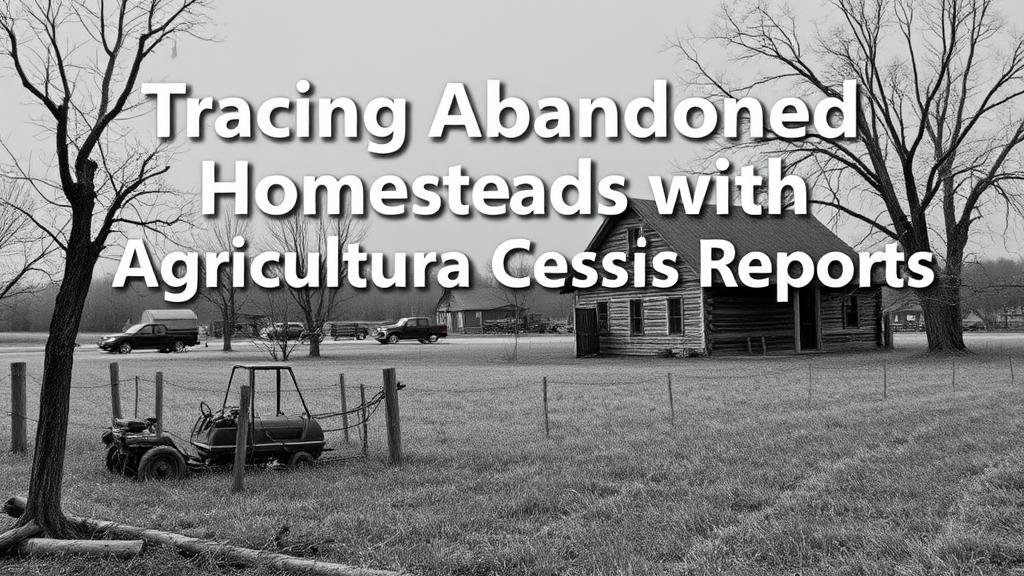Tracing Abandoned Homesteads with Agricultural Census Reports
Tracing Abandoned Homesteads with Agricultural Census Reports
The examination of abandoned homesteads offers critical insights into rural depopulation, shifts in agricultural practices, and socio-economic transformations across regions. Agricultural census reports serve as valuable resources in tracing these abandoned sites, as they contain systematic data on land use, ownership, and farming trends over time. This article aims to elucidate the methodology behind utilizing agricultural census reports to identify and study abandoned homesteads, supported by historical context and specific case studies.
Understanding Agricultural Census Reports
Agricultural census reports, conducted periodically, provide comprehensive data regarding agricultural production, land ownership, and demographics related to farming communities. In the United States, these reports date back to the 19th century, with the first agricultural census conducted in 1840. The data collected encompasses key variables such as:
- Number of farms
- Land area cultivated
- Type of crops grown
- Livestock counts
- Farm operator demographics
This structured information can play a pivotal role in understanding patterns that indicate abandonment. For example, consistently declining farm numbers or a decrease in farm size over several census years can signal increased abandonments.
Case Study: The Midwest Region
Examining the Midwest, particularly states like Iowa and Nebraska, reveals an alarming trend of rural depopulation linked to agricultural practices and economic transitions. According to the 1920 Agricultural Census, Iowa had over 190,000 farms, but by 2020, this number had dwindled to around 88,000, reflecting a significant reduction in agricultural engagement.
For example, the town of Coon Rapids, Iowa, faced a substantial decline in active homesteads due to mechanization and the consolidation of farms. The census data highlighted a shift from small, family-owned farms to larger, corporate agricultural entities. As families sought opportunities elsewhere, homesteads were abandoned, leaving a historical footprint that can now be traced through these census reports.
Methodology for Tracing Abandoned Homesteads
To effectively trace abandoned homesteads, researchers typically follow a series of methodological steps:
- Data Collection: Gather agricultural census data over an extended period, focusing on specific regions.
- Trend Analysis: Identify patterns, such as decreasing farm sizes or numbers, across the census years.
- Geospatial Mapping: Use GIS technology to overlay historical census data with current land use maps to visually analyze changes.
- Field Verification: Conduct on-site visits to corroborate census findings with physical evidence of abandonment.
This thorough methodological approach allows for a nuanced understanding of the forces driving rural abandonment and the legacies left behind.
The Impact of Policy Changes
As evidenced in the data, various policy changes have greatly influenced agricultural practices and, subsequently, the fate of homesteads. implementation of policies such as the Agricultural Adjustment Act (AAA) in the 1930s aimed to stabilize agricultural prices but inadvertently led to the abandonment of smaller farms unable to compete. This resulted in the decline of rural populations, further documented in census reports of the following years.
According to a study by the Economic Research Service (ERS), small farms, which constituted approximately 60% of all farms in the 1950s, dropped to under 30% by 2020. This transition not only resulted in the physical abandonment of homesteads but also a loss of cultural heritage as traditional farming practices disappeared from the landscape.
Real-World Applications
Utilizing agricultural census reports to trace abandoned homesteads provides several real-world applications:
- Urban Planning: Insights from tracing abandoned homesteads can inform urban renewal projects and land reclamation strategies.
- Cultural Heritage Preservation: Identifying historical homesteads allows for targeted efforts to preserve local history.
- Socioeconomic Research: Understanding rural decline enables targeted interventions to aid communities facing economic challenges.
These applications demonstrate the importance of the intersection between historical data and contemporary planning initiatives.
Conclusion
Tracing abandoned homesteads through agricultural census reports is a vital academic endeavor that opens avenues for historical inquiry, policy analysis, and community revitalization efforts. By systematically analyzing data trends over time, researchers and policymakers can better understand the complexities of rural depopulation and the legacies of agricultural practices. This approach not only illuminates the past but also shapes the future of rural landscapes in the United States.
Future research should continue to integrate interdisciplinary methodologies, blending quantitative data from census reports with qualitative insights from local histories and oral narratives, thereby enriching the understanding of abandoned homesteads and their significance within broader socio-economic contexts.



